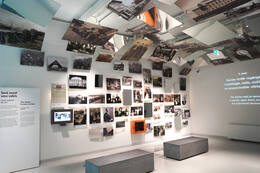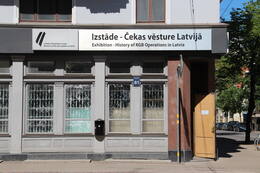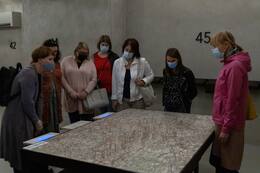Anti-Soviet agitation and propaganda
IV Soviet Occupation
"Anti-Soviet agitation and propaganda" - a highly ideological term that was introduced into the criminal legislation of the USSR since the 1920s and was one of the most frequently used articles of the law in political trials. In the 1926 Criminal Code of the CPSU, responsibility for "anti-Soviet agitation and propaganda" was established in Article 58.
After the occupation of Latvia, in November 1940, this Criminal Code was also introduced in Latvia, with retroactive effect. In 1961, the Criminal Code of the Latvian SSR was adopted and entered into force, in which liability for "anti-Soviet agitation and propaganda" was provided for in Article 65. The penalty specified in the sanction of this article provided for "deprivation of liberty for a period of six months to seven years", as well as "establishment for a period of two to five years". In turn, for persons who had previously been convicted of "especially dangerous state crimes", the second part of Article 65 provided for a penalty of even "from three to ten years" in prison, in addition to "establishment for a period of two to five years".
The last political criminal cases in the KGB's criminal cases fund of the Latvian State Archives date back to 1986. The KGB managed to take a great many documents to Russia or destroy them at the turn of the 1980s and 1990s.
More information sources
1983 Political Trials in Occupied Latvia. Virtual Exhibition. Latvian National Archives, 2013. http://www.archiv.org.lv/1983/index.php?id=303
Gints Zelmenis, Bruno Javoišs, Ivo Grundulis. National Resistance Movement in Latvia from 1959 to 1986. Riga, 2019.
Jānis Ķeruss: The Cheka's turn against anti-Soviet propaganda and agitation. Analysis of 1957. https://www.lu.lv/vdkkomisija/zinas/t/23701/
Māra Miķelsone. Historian Zelmenis: the totalitarian regime was sensitive even to symbolic actions. Ir., September 16, 2019. https://ir.lv/2019/09/16/vesturnieks-zelmenis-totalitarais-rezims-bija-jutigs-pret-simboliskam-akcijam/
Related objects
Museum of the Occupation of Latvia
The museum exhibits the history of Latvia from 1940 to 1991, under the occupation of Nazi Germany and the Soviet Union. ‘House of the Future’ is a reconstruction and expansion project of the Occupation Museum designed by the well-known American Latvian architect Gunārs Birkerts as well as the new exhibit of the museum. The exhibit ‘History of Cheka in Latvia’ was created by the Occupation Museum and it is located in the ‘Corner House’, which is the former USSR State Security Committee (KGB) building. Latvian Occupation Museum was founded in 1993. It tells the long-hidden story of the fate of the Latvian state, nation and land under the occupation of two foreign totalitarian powers from 1940 to 1991. At the end of 2020 the museum had more than 70,000 different historical items (documents, photographs, written, oral and material evidence, objects and memorabilia). Museum specialists have recorded more than 2,400 video testimonials, making it one of the largest collections on occupation in Europe. The events that unfolded in Latvia, Lithuania and Estonia clearly show us what the nations had to endure under the two totalitarian regimes.
Exhibition in the KGB Building "History of KGB Operations in Latvia"
The former USSR State Security Committee (commonly known as Cheka) building is open for visitors. Here chekists imprisoned, interrogated and murdered Latvian citizens who were considered opponents by the occupation regime. There is also an exhibit from the Latvian Occupation Museum on the activities of Cheka in Latvia. Guided tours of the prison cells, corridors, basement and courtyard are available. The house was built in 1911 and it is one of the most beautiful buildings in Riga. Called the ‘Corner House’ by the people, it was the scariest symbol of the Soviet occupation regime in Latvia, and also one of the pillars of power of the USSR. Cheka operated from the Corner House during the occupation from 1940 to 1941 and then again from 1945 to 1991. Tens of thousands of Latvians were affected by direct political persecution. The fight against enemies of Soviet rule continued also after World War II. Cheka’s approach towards its operation slightly changed after Stalin’s death. Physical torture was replaced by psychological terror. The majority of Cheka agents were Latvians (52%). Russians were the second largest group – 23.7%. 60.3% of the agents were not members of the Communist Party. 26.9% of the agents had higher education. The system was designed in a way to involve local people and thus have greater control over the society. Staff documents and service records are located in Russia. And these materials have not been made available to Latvian authorities and researchers.
Historical Exposition “The Burning Conscience”
The historical exhibit ‘Fire of Conscience’ is located in Cēsis, near the Cēsis Castle Square. Established in a Soviet-era temporary detention facility, it tells about the occupation of Latvia and reveals surprising and heroic stories of resistance from individuals. The yard features a memorial wall with the names of 643 residents of the former Cēsis district who died in Soviet repressions, including national partisans deported in 1941 and 1949 and those shot and sentenced to death. The exhibit’s timeline encourages visitors to study the course of the occupation of Latvia from 1939 to 1957. Arranged by topics, quotes from local newspapers offer a comparison of the political propaganda of the two occupation regimes. The six cells for temporary detention have survived to the present day in their original form from 1940 to 1941 and the post-war years. Here, the residents of Cēsis district, detained for various anti-Soviet activities, including national partisans, their supporters, young people who distributed anti-Soviet leaflets and other ‘traitors of the motherland’, were held for several days during the initial investigation and interrogation before being sent to the main KGB Building in Riga. Everything here is real: cells with iron doors, built-in ‘kormushkas’ (small openings for providing food), plank beds, a latrine for detainees, a small kitchen with an oven, as well as typical Soviet-era oil paint on the walls. In 2019, the exhibit was ranked third in the national design competition, the Latvian Design of the Year Award.
Related stories
Liepāja - at the crossroads of various historical events
The inhabitants of Liepāja were among the first in Latvia to experience the outbreak of the Second World War and among the last for whom the war ended both literally and symbolically. The Second World War and the Soviet occupation of Liepāja ended only in 1994, when the last troops of the USSR's heir, Russia, left the city.







